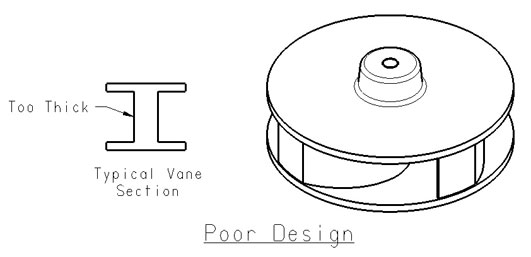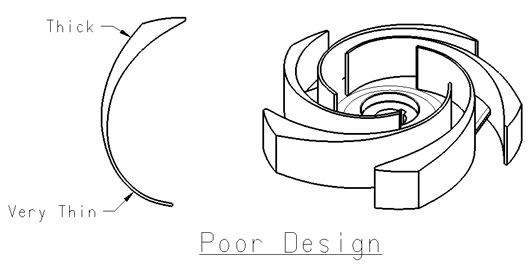Top 5 Design Mistakes in High Chrome White Iron Castings
on February 15, 2017High chrome white iron, or ASTM A532 is a highly abrasion resistant alloy that outperforms chromium carbide overlay (CCO), steel and AR 400 in a variety of wear applications.
The Design Process
During the design process, an engineer will ensure that a component functions as necessary and has the properties, including strength, required to meet expectations. The foundry then has to produce a casting that exhibits all the properties that the designer built into the component.
Unfortunately, it is common for the designer to misunderstand the foundry process and engineer a component that cannot be manufactured in a commercially viable manner, free from structural anomalies.
The best course of action is for the design engineer to involve the foundry engineer early on in the design phase. This will allow the foundry engineer to make casting-specific suggestions that will improve the soundness of the final product.
Outlined below are the top 5 design mistakes that we see when designers create a part that is to be made in high chrome white iron (ASTM A532).
Mistake 1: Sharp Internal Corners
Sharp corners create a hot spot causing contraction to occur at different rates. This will lead to stress and cracking.

Mistake 2: Different Section Thicknesses
Having different section thicknesses leads to different cooling rates, causing porosity, stress and cracking. If section thicknesses must be different, it is imperative that the heavy sections are accessible by the foundry so that a riser can be installed that will feed this section.

Mistake 3: Too many sections coming together
Bringing too many sections together leads to extended cooling times, again causing porosity, stress and cracking. A properly designed casting brings as few sections together as possible.

Mistake 4: Too complex a part
Not every shape imaginable should be made as a one-piece casting. Sometimes it is too complex and would demand conflicting sections, ribs, cross-members, etc. that will cause serious flaws. With today’s improved machinability of high chrome white iron, consider making 2 or 3 simple parts that can be joined together, instead of one complex part that may result in a non-conforming part.
Case Study: Download this free case study to learn how Penticton Foundry helped a company improve wear time through design assistance.
Mistake 5: Too thin of a section
High chrome white iron is less fluid than ductile or gray iron. If a thin section doesn’t run during pouring, this can lead to cold shuts or misruns. It is not only important to have sections as uniform as possible, it is also important to make sections thick enough that the advancing metal will flow properly during mould-filling.

To learn more about high chrome white iron, please refer to our abrasion resistant alloys page.
